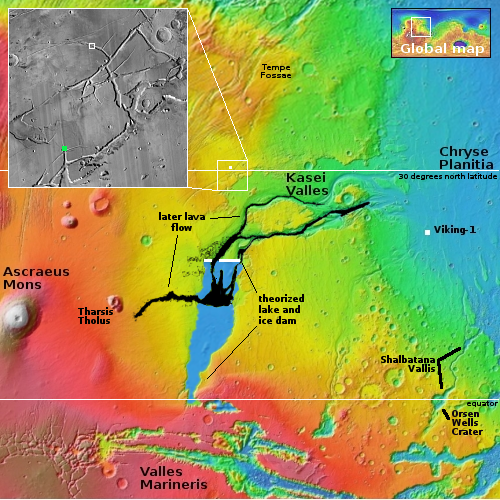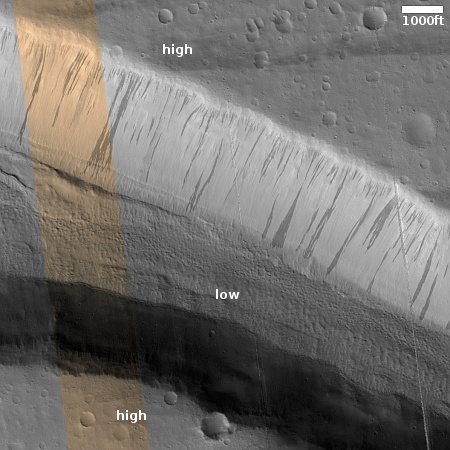A big crack on Mars
Cool image time! The picture to the right, cropped, reduced, and sharpened to post here, was taken on September 1, 2024 by the high resolution camera on Mars Reconnaissance Orbiter (MRO). It shows what the scientists label “a fracture with clays.”
This canyon is about a mile and a half wide, with the floor ranging from 800 to 1,100 feet to the rim. It was not formed initially by any ice or water flow, but by a spreading of the crust, forcing cracks to form that might have later been modified by wind, ice, or water. The presence of clays in this canyon strengthens that later ice/water modification, as clays require water to form.
The streaks on the northern wall are slope streaks, an unexplained phenomenon unique to Mars. While at first glance they look like avalanches, they have no debris piles at their base, and do nothing to change the topography. In fact, streaks can sometimes go uphill for short distances, following the surface. They happen randomly throughout the year, and fade with time.
It is believed their cause is related to dust avalanches, but this is only one of a number of theories that attempt to explain them. None is entirely satisfactory.

The white dot on the overview map to the right marks the location, on the northern edge of a network of canyons that feed south into Kasei Vallis, one of the longest and largest canyon systems on Mars. Scientists believe this the main canyon, 1,500 miles long and 300 miles wide in places, was formed by one or more catastrophic floods that poured out of the region where all Mars’ largest volcanos sit to drain into the northern lowland plains.
The original of the network of fractures where this canyon is located is not as clear. The canyons appear to follow fault lines, suggesting they formed when underground pressure pushed up and cracked the surface. Yet their pattern suggests they were widened by flows of ice or water south along those fault lines into Kasei. This suggestion is further reinforced by a cave opening, indicated by the green dot, that is found at the head of one canyon to the south. It is unlikely that small cave formed the entire downhill canyon, bu as I noted in my post first describing it,
The data illustrated by these images makes that tiny pit most enticing. It not only appears to be relatively easy to access its interior, there is visual evidence that suggests the presence of water.
If I was a future settler of Mars, I would give this pit a very high priority for exploration.
The canyon in the picture above is in many ways as enticing, as it is located at 31 degrees north latitude, which makes the existence of near-surface ice quite possible.
On Christmas Eve 1968 three Americans became the first humans to visit another world. What they did to celebrate was unexpected and profound, and will be remembered throughout all human history. Genesis: the Story of Apollo 8, Robert Zimmerman's classic history of humanity's first journey to another world, tells that story, and it is now available as both an ebook and an audiobook, both with a foreword by Valerie Anders and a new introduction by Robert Zimmerman.
The print edition can be purchased at Amazon or from any other book seller. If you want an autographed copy the price is $60 for the hardback and $45 for the paperback, plus $8 shipping for each. Go here for purchasing details. The ebook is available everywhere for $5.99 (before discount) at amazon, or direct from my ebook publisher, ebookit. If you buy it from ebookit you don't support the big tech companies and the author gets a bigger cut much sooner.
The audiobook is also available at all these vendors, and is also free with a 30-day trial membership to Audible.
"Not simply about one mission, [Genesis] is also the history of America's quest for the moon... Zimmerman has done a masterful job of tying disparate events together into a solid account of one of America's greatest human triumphs."--San Antonio Express-News
Cool image time! The picture to the right, cropped, reduced, and sharpened to post here, was taken on September 1, 2024 by the high resolution camera on Mars Reconnaissance Orbiter (MRO). It shows what the scientists label “a fracture with clays.”
This canyon is about a mile and a half wide, with the floor ranging from 800 to 1,100 feet to the rim. It was not formed initially by any ice or water flow, but by a spreading of the crust, forcing cracks to form that might have later been modified by wind, ice, or water. The presence of clays in this canyon strengthens that later ice/water modification, as clays require water to form.
The streaks on the northern wall are slope streaks, an unexplained phenomenon unique to Mars. While at first glance they look like avalanches, they have no debris piles at their base, and do nothing to change the topography. In fact, streaks can sometimes go uphill for short distances, following the surface. They happen randomly throughout the year, and fade with time.
It is believed their cause is related to dust avalanches, but this is only one of a number of theories that attempt to explain them. None is entirely satisfactory.

The white dot on the overview map to the right marks the location, on the northern edge of a network of canyons that feed south into Kasei Vallis, one of the longest and largest canyon systems on Mars. Scientists believe this the main canyon, 1,500 miles long and 300 miles wide in places, was formed by one or more catastrophic floods that poured out of the region where all Mars’ largest volcanos sit to drain into the northern lowland plains.
The original of the network of fractures where this canyon is located is not as clear. The canyons appear to follow fault lines, suggesting they formed when underground pressure pushed up and cracked the surface. Yet their pattern suggests they were widened by flows of ice or water south along those fault lines into Kasei. This suggestion is further reinforced by a cave opening, indicated by the green dot, that is found at the head of one canyon to the south. It is unlikely that small cave formed the entire downhill canyon, bu as I noted in my post first describing it,
The data illustrated by these images makes that tiny pit most enticing. It not only appears to be relatively easy to access its interior, there is visual evidence that suggests the presence of water.
If I was a future settler of Mars, I would give this pit a very high priority for exploration.
The canyon in the picture above is in many ways as enticing, as it is located at 31 degrees north latitude, which makes the existence of near-surface ice quite possible.
On Christmas Eve 1968 three Americans became the first humans to visit another world. What they did to celebrate was unexpected and profound, and will be remembered throughout all human history. Genesis: the Story of Apollo 8, Robert Zimmerman's classic history of humanity's first journey to another world, tells that story, and it is now available as both an ebook and an audiobook, both with a foreword by Valerie Anders and a new introduction by Robert Zimmerman.
The print edition can be purchased at Amazon or from any other book seller. If you want an autographed copy the price is $60 for the hardback and $45 for the paperback, plus $8 shipping for each. Go here for purchasing details. The ebook is available everywhere for $5.99 (before discount) at amazon, or direct from my ebook publisher, ebookit. If you buy it from ebookit you don't support the big tech companies and the author gets a bigger cut much sooner.
The audiobook is also available at all these vendors, and is also free with a 30-day trial membership to Audible.
"Not simply about one mission, [Genesis] is also the history of America's quest for the moon... Zimmerman has done a masterful job of tying disparate events together into a solid account of one of America's greatest human triumphs."--San Antonio Express-News


